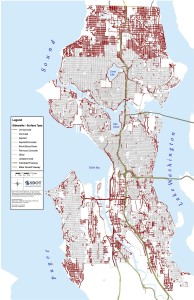
There may be solutions soon for one of Seattle’s longest-lasting infrastructure problems. Since the middle of last century when the City annexed land in what is now north Seattle, little progress has been made in building hundreds of miles of missing sidewalks in North Seattle and across the city. North Seattle residents who voted for annexation claim that the city promised sidewalks and failed to deliver. A multi-billion dollar price tag to build all missing sidewalks has been too intimidating for anyone to find real solutions.
However, after decades of minimal progress, wholesale solutions to bring sidewalks to Seattle may be closer than ever. While most conversations about this problem have been around building traditional concrete sidewalks, the Seattle Department of Transportation is now evaluating more affordable alternatives. And, to overcome the funding gulf that remains, city council candidate Sandy Brown has a potential answer.
While North Seattle isn’t the only part of the city without adequate sidewalk infrastructure, this part of the city is less likely to have sidewalks than anywhere else. Before 1940, the Seattle city limits extended no farther north than N 85th Street. Over the next 14 years, territory was added piece-by-piece, until in January 1954 the northern boundary of Seattle was set at 145th St as it is today.
It is at N 85th Street where City Council District 5 begins. The newly-formed district covers much of the land that was annexed in the middle of the last century, continuing all the way to Seattle’s northern border — an area where 68% of blocks lack any sidewalks, according to SDOT. Many people say that this part of Seattle has been under-represented in local politics for years, something that is due to change with Seattle’s first district-based city council election on November 3rd.

For the first time, residents in this part of the city will have a council member in City Hall specifically elected to represent them. Sidewalks have been a talking point of the campaign thus far, and Sandy Brown has an idea of how to pay for them.

The idea, to establish local improvement districts (LIDs), is actually an old one — it’s how neighborhood improvements like sidewalks were funded before the Great Depression. By dividing North Seattle into local improvement districts, residents in each district could vote to tax themselves to pay for sidewalks. It would be an investment by residents that would pay off in the form of increased property values and the benefit of having sidewalks in the neighborhood.
However, the cost of sidewalks has gone up since the Great Depression as it now costs SDOT $250,000 to $350,000 to build one block of sidewalks. Fortunately, there are affordable options on the horizon.
SDOT is updating Seattle’s Pedestrian Master Plan, a document which guides the City on making improvements “to make Seattle the most walkable city in the nation,” according to SDOT. As part of this update, SDOT is considering alternatives to pricey traditional sidewalks.
These walkways would bring safety improvements for people who walk at a fraction of the cost of what it would take to build curbs, drainage, and concrete sidewalks that are more typical. SDOT is soliciting feedback from residents through an online survey.

SDOT appears to be considering options like raised asphalt sidewalks, separating pedestrians from traffic by curbs, or just implementing traffic-calming features like speed bumps to make roads without sidewalks feel safe to be shared by people driving, biking, and walking. There are other options as well, which can be seen on their Pedestrian Master Plan survey.
While substantial improvement is still years away, if SDOT can find an option that works for walkers at a lower cost, and funding sources can be found, our decades-long infrastructure embarrassment of sidewalk-free streets may start to come to an end.
Troy is a pedestrian advocate who serves on the board of Seattle Neighborhood Greenways. He loves cities and walking, hiking, and biking. He wrote a book to help others looking to find the right place for them, called Move to the Place of Your Dreams: A Relocation Handbook. By day, he is a professional consultant for a technology firm.

